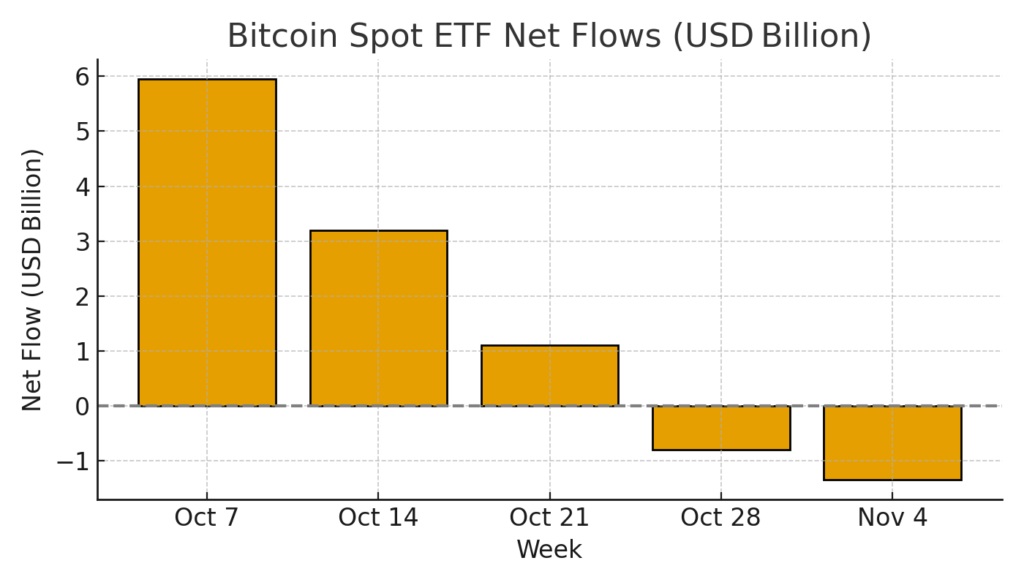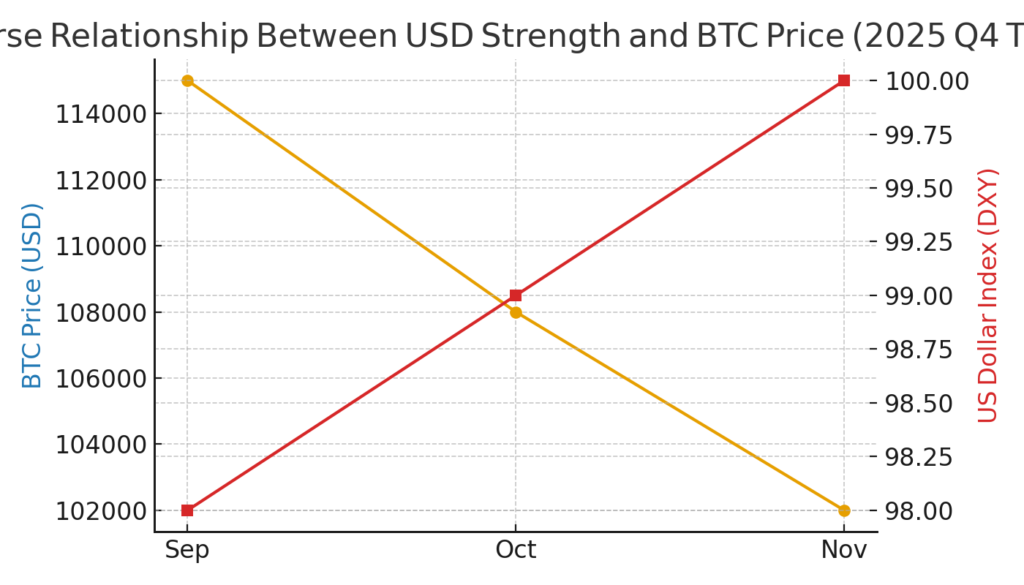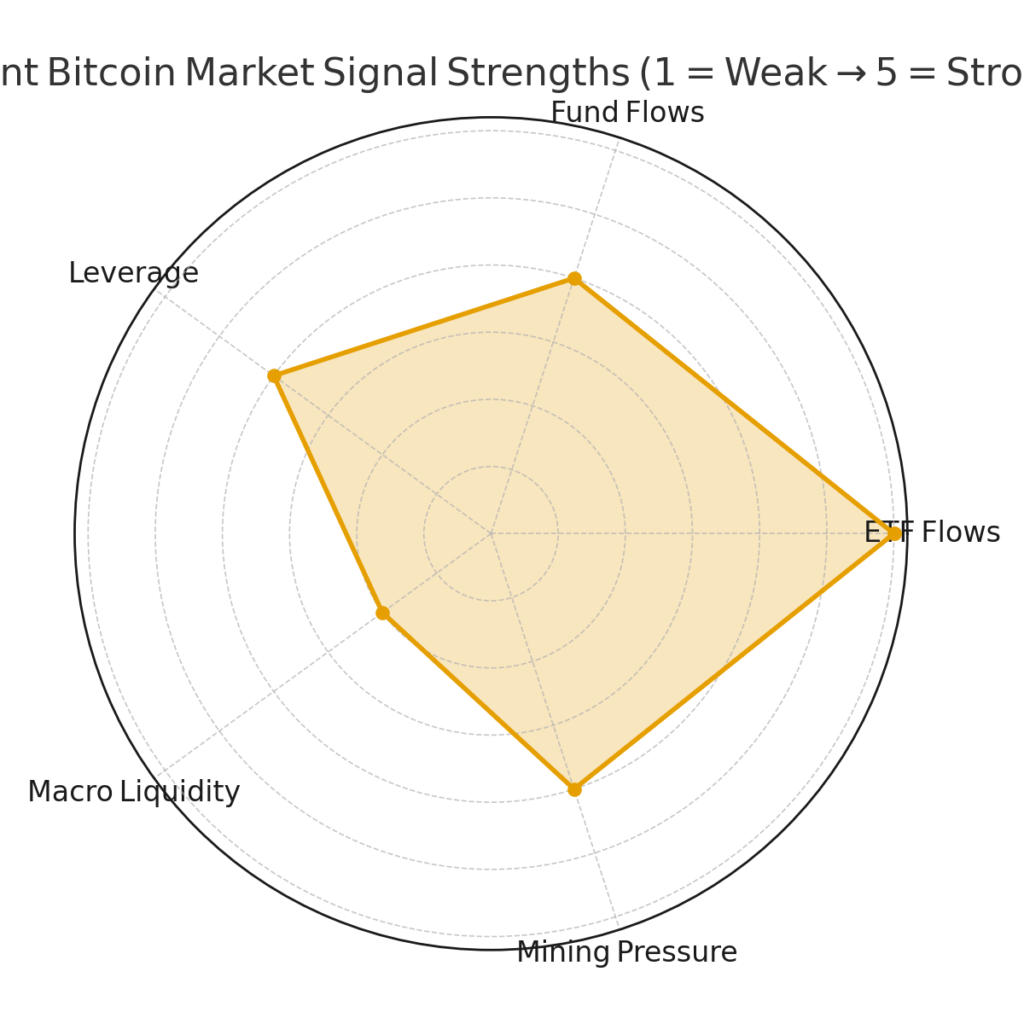
Main Points :
- Spot-ETF flows have turned negative and may be shifting from support to supply.
- Broader fund flows into crypto are weak, indicating institutional demand fatigue.
- Leverage and derivatives metrics (futures premium, funding rates) point to stress in the market.
- Macro liquidity conditions—strong dollar, elevated real yields—are suppressing risk assets like Bitcoin.
- Mining supply pressures (hash-price, miner sell-offs) add another potential drag on the price.
1. ETF Flows: From Buy Support to Potential Sell Pressure

Recent coverage highlights that although many institutions and companies are ostensibly buying Bitcoin, the price has nevertheless fallen—contradicting the common narrative of “institutions buying the dip.” One of the direct causes: the flows into spot-Bitcoin ETFs (such as IBIT and FBTC) have turned negative. In short: what had been a source of upward price support is now, in effect, converting into selling pressure.
For example, one article notes that US spot Bitcoin ETFs recorded roughly US$186.5 million in redemptions on Monday 3 Nov, and about US$1.34 billion over the four-session span from 29 Oct. The sharp reduction in inflows—down by as much as 90 % year-to-date for some funds—is a warning sign.
From the point of view of someone searching for new crypto assets or income opportunities, this shift suggests the market’s “easy fuel” may be evaporating. When ETF flows turn from positive support into supply, it raises the bar for other catalysts (new entrants, protocol upgrades, real-world adoption) to carry the next move up.
2. Broad Fund Flows: Institutional Demand Is Fading
Beyond spot-ETFs, the broader theme is weakening institutional demand. Articles note that while earlier in the year there were record flows into crypto funds (for example, one report gave US$5.95 billion in weekly inflows into global crypto ETFs in early October). But in November, the narrative has changed to large outflows and depressed flows overall.
This fatigue is significant: the more the big players sit on the sidelines (or reduce exposure), the more the “next up” move depends on new types of buyers (retail, new jurisdictions), or new utility/innovation, rather than just “money keeps coming in.” For those looking at new crypto assets, the implication is clear: you cannot rely solely on passive flows to carry the asset; you will need a differentiator—real use-case, real world adoption or other disruptive quality.
3. Leverage & Derivatives: Market Stress Indicators
Another key vector: derivatives markets. When futures basis (i.e., futures price minus spot price) compresses, and when funding rates turn negative (i.e., longs paying shorts), it suggests reduced bullish bets and possible risk of forced selling. According to one market-outlook article, the current setup is marked by “leverage washed out, on-chain demand looks steady, and seasonality is a tailwind” — but the key is whether derivatives metrics improve or continue to hurt.
In other words: if one sees futures premium widening again, positive funding, it may signal the bulls are returning. Conversely, further compression or negative funding suggests the down-move may not be over. For real-world blockchain application enthusiasts, this suggests that timing matters: entering assets or protocols when leverage is re-emerging might signal renewed momentum.
4. Macro Liquidity: Dollars, Yields, and Risk Assets

Even if everything else were benign, macro-liquidity remains a major headwind. A strong US dollar index (DXY moving from ~98 toward ~100) and elevated US 10-year yields (~4.1 %) suggest global risk assets—such as crypto—face pressure from higher real rates and tighter liquidity. These conditions compress the “risk premium” investors are willing to accept. The Japanese article referenced these exact factors.
From our external research: one piece notes that October’s sharp correction was partly triggered by a “Fed pivot” dream dashed, and a bounce in the dollar and yields. For someone watching blockchain tech and new assets: this means that even the most promising protocol may struggle if macro winds are unfavorable. Therefore, identifying assets with real-world revenue streams (not purely speculative) becomes more important in this environment.
5. Mining Supply Pressure: Hash-Price, Sell-Off Risks

The final of the five signals centres on supply pressure from mining operations. The Japanese article points out two key supply side risks: (a) the elongated repayment deadline for Mt. Gox (until 31 Oct 2026) which holds the potential for a large sell-off, and (b) the post-halving low hash-price that motivates miners to liquidate holdings rather than hold for the long term.
This dynamic remains relevant today. With mining costs rising and profitability under pressure (despite halving), miners are increasingly selling into the market, which adds to supply coping. For new crypto assets: in environments where the flagship (Bitcoin) has looming supply pressure, it may create rotational interest into altcoins or protocols which avoid those specific overhangs—provided they have solid fundamentals.
Putting It All Together: Where Does the Market Stand?
The market right now appears to be in a mid-cycle reset rather than the outright end of the bull cycle. As one analysis put it: “The drop hit crypto broadly and sparked a wave of forced selling… If macro winds calm and flows turn positive, the market has the ingredients for a rebound.”
However, there is also a caution: if the price fails to stabilise above the ~US$110,000 to US$115,000 region (for Bitcoin) and one or more of the five signals fail to improve, the next logical support zone may be in the mid-US$90,000s region. The Japanese article referenced ~US$100,000 breaking and a view toward ~US$90,000 if the rebound fails.
For those focusing on new crypto assets, this environment suggests two possible tactics:
- Opportunity Entry: If you see clear signal improvements (e.g., ETF inflows turn positive, macro liquidity eases, miners stabilise), then the asset class may be poised for broader strength—and you may consider positioning in up-and-coming protocols with real utility.
- Rotation Play: If Bitcoin’s dominance weakens, and supply pressure mounts therein, there may be relative opportunity in alt-protocols, layer-1s, staking ecosystems, or blockchain application tokens which sidestep the specific drag factors impacting BTC (like miner sell-off).
Conclusion
The five signals discussed—ETF flows, broader fund demand, derivatives/leverage metrics, macro liquidity conditions, and mining supply pressure—serve as a useful checklist for assessing whether the crypto market (and specifically Bitcoin) is ready to rebound or poised for further correction. For investors and practitioners seeking the next generation crypto asset or new sources of yield, the takeaway is clear: you cannot afford to view crypto as decoupled from flows, derivatives or macro conditions.
Thus, when evaluating any prospective asset or protocol today, ask yourself:
- Is there institutional flow momentum (or at least no flow erosion)?
- Are derivatives markets signalling conviction rather than stress?
- Is macro liquidity supportive of risk assets?
- Does the supply side (token issuance, miner holdings, lock-ups) avoid latent overhangs?
- Does the protocol have real-world usage, revenue or utility rather than doing little but rallying on hype?
If you check most of those boxes, then you may be well-positioned for the next leg upward. If many are “unchecked,” then you may either wait for the reset to complete or look to assets that are less flow-dependent and more driven by utility.

